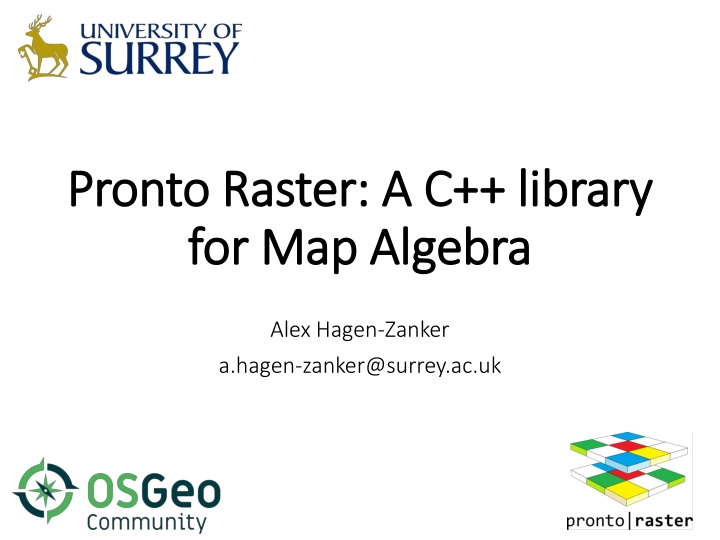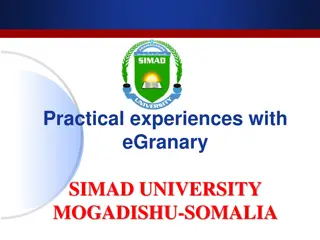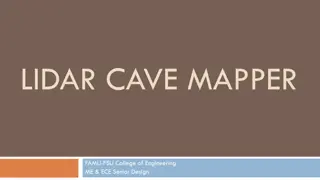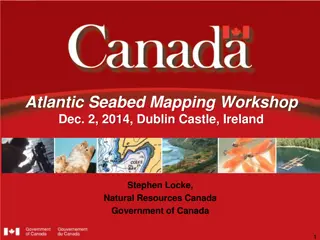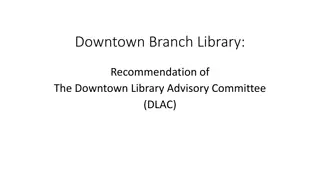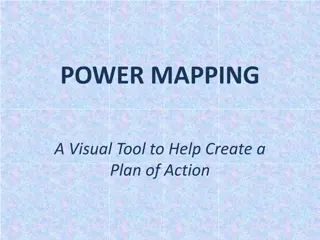Advanced Mapping Library for Geocomputational Research
A new C++ library, Pronto Raster, offers extensive support for map algebra, local, focal, and zonal operations on raster data. Aimed at researchers and consultants in geocomputational fields, it addresses key challenges like customization, scalability, efficiency, flexibility, and usability with its idiomatic interface. The design includes concepts of Raster and Raster View for efficient data handling. Compatible with other libraries, it provides a robust solution for working with large raster datasets.
Download Presentation

Please find below an Image/Link to download the presentation.
The content on the website is provided AS IS for your information and personal use only. It may not be sold, licensed, or shared on other websites without obtaining consent from the author.If you encounter any issues during the download, it is possible that the publisher has removed the file from their server.
You are allowed to download the files provided on this website for personal or commercial use, subject to the condition that they are used lawfully. All files are the property of their respective owners.
The content on the website is provided AS IS for your information and personal use only. It may not be sold, licensed, or shared on other websites without obtaining consent from the author.
E N D
Presentation Transcript
Pronto Raster: A C++ library Pronto Raster: A C++ library for Map Algebra for Map Algebra Alex Hagen-Zanker a.hagen-zanker@surrey.ac.uk
Map algebra Local operations Focal operations Zonal operations A B B B 5 3 A B A B 1 3 2 A A A B 2 + = 1 2 1 2 4 2 2 4 4 3 4 3 2 13 = = Zone 7 A 17 B 13 https://github.com/ahhz/raster
That is basic! Dont we have tools? Geodata management: GDAL, Proj, GeoTIFF, etc. Image processing: OpenCV, GIL, etc. Linear algebra: Eigen, Blitz, UBLAS, etc. Scripting languages: ArcGIS Python, PC Raster, R - raster, Geotrellis GIS software: Raster Calculator and specific tools in QGIS, SAGA ArcGIS All of these facilitate Map Algebra operations, but none meets all (my) requirements https://github.com/ahhz/raster
Expected user and requirements Researcher / consultant working in geocomputational domain who does not like being constrained by built-in methods Requirement Key challenge Customizable Be able to apply custom local, focal and zonal functions on any number of layers Scalable Work with large raster data sets that exceed available memory Efficient Minimal creation of temporary datasets for intermediary results Flexible Work with wide range of data types with no need for data preprocessing Usable Idiomatic interface, minimal use of boiler plate code Compatible Be able to use in conjunction with other libraries (e.g. for optimization, simulation control, etc.) https://github.com/ahhz/raster
Design: Raster and Raster View concepts Range* Raster A Range of which we know the number of rows and columns. And, must also give access to sub-raster . Gives access to a sequence of values through iterator access. Unlike a Container does not have to store its own values Range View Raster View A Raster that is also a View. A Range that can be copied O(1) and is meant to be passed to functions by value *Official proposal to C++ standard, see also https://ericniebler.github.io/range-v3/ https://github.com/ahhz/raster
Design: Raster and Raster View concepts Concept Main requirements iterator_type begin(); iterator_type end(); Range size_type size(); Sized copy-constructor O(1) View sub_type sub_raster(start_row, start_col, rows, cols); size_type rows(); size_type cols(); Raster https://github.com/ahhz/raster
Using the Raster concept (1) Use GDAL to open a raster dataset as a model of the Raster View concept #include <pronto/raster/io.h> namespace pr = pronto::raster; int main() { auto ras = pr::open<int>("my_file.tif") int sum = 0; for(auto&& v : ras) { sum += v; } } Use range-based for-loop to iterate over all values in the raster https://github.com/ahhz/raster
Using the Raster concept (2) #include <pronto/raster/io.h> namespace pr = pronto::raster; int main() { auto ras = pr::open<int>("my_file.tif") int sum = 0; for(auto&& v : ras.sub_raster(2,3,10,20)) { sum += v; } } Iterate over subset of the raster. First cell at (2,3) then 10 rows and 20 columns https://github.com/ahhz/raster
Design: Expression Templates (ET) for local operations Local operations take Raster Views as input and produce an ET as output that also is a Raster View. Cell values of the ET are only calculated once they are iterated over No need to allocate memory Input and output conform to the same concept: highly composable A generic function, transform, is implemented, other local functions can be implemented in terms of transform https://github.com/ahhz/raster
Using local operations(1) #include <pronto/raster/io.h> #include <pronto/raster/transform_raster_view.h> #include <functional> namespace pr = pronto::raster; Open two datasets int main() { auto a = pr::open<int>("a.tif"); auto b = pr::open<int>("b.tif"); Create a Raster View that applies std::plus to each cell of both input datasets auto sum = pr::transform(std::plus<int>, a, b); for(auto&& v : sum.sub_raster(2,3,10,20)) { // do something } } Iterate over a sub-raster of the Raster View and calculate the required values only https://github.com/ahhz/raster
Using local operations(2) Create a RasterView of square of differences in two steps auto a = pr::open<int>("a.tif"); auto b = pr::open<int>("b.tif"); auto diff = pr::transform(std::minus<int>, a, b); auto sqr_lambda = [](int x){return x*x;}; auto sqr_diff = pr::transform(sqr_lambda, diff); Iterate over values, without allocating extra memory, or creating temporary dataset. int sum_of_squared_diff = 0; for(auto&& v : square_diff) { sum_of_squared_diff += v; } https://github.com/ahhz/raster
Using local operations(3) #include <pronto/raster/io.h> #include <pronto/raster/raster_algebra_operators.h> #include <pronto/raster/raster_algebra_wrapper.h> namespace pr = pronto::raster; Wrap a and b in raster_algebra_wrapper to allow use of overloaded operators int main() { auto a = pr::raster_algebra_wrap(br::open<int>("a.tif")); auto b = pr::raster_algebra_wrap(br::open<int>("b.tif")); auto square_diff = (a b) * (a b); for(auto&& v : square_diff) { Iterate over values. // do something } } https://github.com/ahhz/raster
Design: use optional<T> for flagging and processing nodata values Value type: int 0 3 6 2 5 1 4 0 3 6 2 5 1 4 0 3 6 2 5 1 #include <pronto/raster/io.h> #include <pronto/raster/nodata_transform.h> #include <pronto/raster/plot_raster.h> namespace pr = pronto::raster; int main() { auto in = pr::open<int>("demo.tif"); auto nodata = pr::nodata_to_optional(in, 6); auto un_nodata = pr::optional_to_nodata(nodata, -99); } Value type: std::optional<int> 0 3 - 2 5 1 4 0 3 - 2 5 1 4 0 3 - 2 5 1 Value type: int 0 3 -99 2 5 1 4 0 3 -99 2 5 1 4 0 3 -99 2 5 1 Providing an idiomatic way for functions to skip over missing values or to leave cells unspecified https://github.com/ahhz/raster
Design: fundamental spatial operators avoid copying data Function Effect add const-valued leading and trailing rows and columns with a unmutable value pad as required by the Raster concept sub_raster returns value found at a fixed spatial offset in the input RasterView offset iterate over all pairs of horizontally / vertically adjacent cell pairs h_edge / v_edge https://github.com/ahhz/raster
Design: moving windows as Expression Templates Moving window analysis is a common type of Focal Operation Each cell obtains the value of a summary statistics calculated for cells in a surrounding window Efficient implementations exploit overlap in windows of adjacent cells (especially for large windows) https://github.com/ahhz/raster
Moving window schemes Circular window of edges Circular window of cells O(r x n) r = radius n = raster size Square window of cells Square window of edges O(n) n = raster size Hagen-Zanker, AH (2016) A computational framework for generalized moving windows and its application to landscape pattern analysis International Journal of Applied Earth Observation and Geoinformation. https://github.com/ahhz/raster
Design: Indicator concept Implement statistics in terms of a few functions add(element, weight) subtract(element, weight) add(subtotal, weight) subtract(subtotal, weight) extract() Can be used with moving window methods Can be used for zonal statistics https://github.com/ahhz/raster
Using moving window indicators #include <pronto/raster/moving_window_indicator.h> #include <pronto/raster/indicator/mean.h> Specify circular window with radius of 2 cells. Specify to use the mean statistic. namespace pr = pronto::raster; int main() { auto in = pr::open<int>("my_file.tif"); auto window = pr::circle(2); auto indicator = pr::mean_generator<int>{}; auto out = pr::moving_window_indicator(in, window, indicator); for(auto&& v : out) { // do something } } "out" is a Raster View, satisfying all the same requirements as "in". https://github.com/ahhz/raster
The assign function forces evaluation of lazy Expression Templates #include <pronto/raster/assign.h> #include <pronto/raster/io.h> #include <cmath> Cheap: Create ET for the sqrt of values in my_file.tif namespace pr = pronto::raster; int main() { auto in = pr::open<int>("my_file.tif"); auto sqrt = pr::transform([](int x){return std::sqrt(x);}, in); auto out = pr::create_from_model<float>("sqrt.tif", in); pr::assign(b, out); } Expensive: Create sqrt.tif and write values https://github.com/ahhz/raster
Design: Runtime polymorphism through type erasure Runtime polymorphism is sometimes required operations specified by user (e.g. Raster Calculator) value type of raster dataset unknown at compile time Type erased class Holds Is a Raster View? any_raster<T> Raster View object with value type T Yes any_blind_raster any_raster<T>, where T is a supported type Has: rows(), cols(), sub_raster( ) Lacks: begin(), end() https://github.com/ahhz/raster
Using any_raster<T> pr::any_raster<int> plus_or_minus(bool do_plus) { auto a = pr::open<int>("a.tif"); Runtime decision auto b = pr::open<int>("b.tif"); if(do_plus) { auto x = pr::transform(std::plus<int>, a, b)); return pr::make_any_raster(x); } else { auto y = pr::transform(std::minus<int>, a, b)); return pr::make_any_raster(y); } x and y are different types; but both are Raster Views with int as value type } https://github.com/ahhz/raster
Using any_blind_raster pr::any_blind_raster a_in= pr::open_any("a.tif"); pr::any_blind_raster b_in= pr::open_any("b.tif"); Opened as the appropriate value type auto a = pr::raster_algebra_wrap(a_in); auto b = pr::raster_algebra_wrap(b_in); auto c = (b-a) * (b-a); Raster algebra made to work with any_blind_raster pr::export_any("out.tif", c.unwrap()); Exported to the appropriate value type Unwrap from raster_algebra_wrapper https://github.com/ahhz/raster
Future music: Parallel processing The sub_raster() requirement of Raster Views combined with the Expression Template design allows doing calculation for only a part of the raster For local operations and moving window indicators only the assign function needs to be parallelized Split the rasters into sub-raster blocks Assign all blocks asynchronously And rest of library needs to be thread safe https://github.com/ahhz/raster
Scale dependent landscape metrics Applications Cellular Automata land use model Fuzzy set map comparison https://github.com/ahhz/raster
Conclusions Requirement Key challenge Solution Transform function Indicator concept Generic moving windows Uses GDAL buffering and LRU Customizable Be able to apply custom local, focal and zonal functions on any number of layers Scalable Work with large raster data sets that exceed available memory Efficient Minimal creation of temporary datasets for intermediary results Using expression template Using non-copying spatial operations Potential for parallelization Flexible Work with wide range of data types with no need for data preprocessing Uses GDAL for data access Usable Idiomatic interface, minimal use of boiler plate code Range based for-loop std::optional Compatible Be able to use in conjunction with other libraries (e.g. for optimization, simulation control, etc.) C++ Simple concepts
Thank you! github.com/ahhz/raster a.hagen-zanker@surrey.ac.uk https://github.com/ahhz/raster
